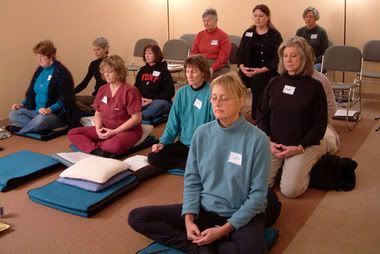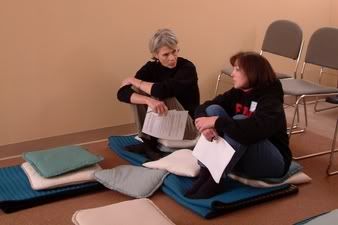A blessed Winter Solstice to you all! Here's a little information from the "Relgious Tolerance" folks. Enjoy! http://www.religioustolerance.org/winter_solstice.htm
Origins of solstice celebration
The seasons of the year are caused by the 23.5º tilt of the earth's axis. Because the earth is rotating like a top or gyroscope, it points in a fixed direction continuously -- towards a point in space near the North Star. But the earth is also revolving around the sun. During half of the year, the southern hemisphere is more exposed to the sun than is the northern hemisphere. During the rest of the year, the reverse is true. At noontime in the Northern Hemisphere the sun appears high in the sky during summertime and low in the sky during winter. The time of the year when the sun reaches its maximum elevation occurs on the day with the greatest number of daylight hours. This is called the
summer solstice, and is typically on JUN-21 -- the first day of summer. "Solstice" is derived from two Latin words: "sol" meaning sun, and "sistere," to cause to stand still. The lowest elevation occurs about DEC-21 and is the winter solstice -- the first day of winter, when the night time hours are maximum.
In pre-historic times, winter was a very difficult time for Aboriginal people in the northern latitudes. The growing season had ended and the tribe had to live off of stored food and whatever animals they could catch. The people would be troubled as the life-giving sun sank lower in the sky each noon. They feared that it would eventually disappear and leave them in permanent darkness and extreme cold. After the winter solstice, they would have reason to celebrate as they saw the sun rising and strengthening once more. Although many months of cold weather remained before spring, they took heart that the return of the warm season was inevitable. The concept of birth and or death/rebirth became associated with the winter solstice. The Aboriginal people had no elaborate instruments to detect the solstice. But they were able to notice a slight elevation of the sun's path within a few days after the solstice -- perhaps by Dec.25. Celebrations were often timed for about the 25th.
December celebrations in many faiths and locations - ancient and modern
ANCIENT EGYPT: The
god-man/savior Osiris died and was entombed on DEC-21. "At midnight, the priests emerged from an inner shrine crying 'The Virgin has brought forth! The light is waxing" and showing the image of a baby to the worshipers."
ANCIENT GREECE: The winter solstice ritual was called Lenaea, the Festival of the Wild Women. In very ancient times, a man representing the harvest god Dionysos was torn to pieces and eaten by a gang of women on this day. Later in the ritual, Dionysos would be reborn as a baby. By classical times, the human sacrifice had been replaced by the killing of a goat. The women's role had changed to that of funeral mourners and observers of the birth.
ANCIENT ROME: Saturnalia began as a feast day for Saturn on DEC-17 and of Ops (DEC-19). About 50
BCE, both were later converted into two day celebrations. During the Empire, the festivals were combined to cover a full week: DEC-17 to 23. By the third century CE, there were many religions and spiritual mysteries being followed within the Roman Empire. Many, if not most, celebrated the birth of their god-man near the time of the solstice. Emperor Aurelian (270 to 275
CE) blended a number of Pagan solstice celebrations of the nativity of such god-men/saviors as Appolo, Attis, Baal, Dionysus, Helios, Hercules, Horus, Mithra, Osiris, Perseus, and Theseus into a single festival called the "Birthday of the Unconquered Sun" on DEC-25. At the time, Mithraism and Christianity were fierce competitors. Aurelian had even declared Mithraism the official religion of the Roman Empire in 274 CE. Christianity won out by becoming the new official religion in the 4th century CE.
ATHEISTS: There has been a recent increase in solstice observances by Atheists in the U.S. For example, The American Atheists and local Atheist groups have organized celebrations for 2000-DEC, including the Great North Texas Infidel Bash in Weatherford TX; Winter Solstice bash in Roselle NJ; Winter Solstice Parties in York PA, Boise ID, North Bethesda MD, and Des Moines IA; Winter Solstice Gatherings in Phoenix AZ and Denver CO: a Year End Awards and Review Dinner (YEAR) in San Francisco, CA.
BUDDHISM: On DEC-8, or on the Sunday immediately preceding, Buddhists celebrate Bodhi Day (a.k.a. Rohatsu). It recalls the day in 596
BCE, when the Buddha achieved enlightenment. He had left his family and possessions behind at the age of 29, and sought the meaning of life -- particularly the reasons for its hardships. He studied under many spiritual teachers without success. Finally, he sat under a pipal tree and vowed that he would stay there until he found what he was seeking. On the morning of the eighth day, he realized that everyone suffers due to ignorance. But ignorance can be overcome through the Eightfold Path that he advocated. This day is generally regarded as the birth day of Buddhism. Being an Eastern tradition, Bodhi Day has none of the associations with the solstice and seasonal changes found in other religious observances at this time of year. However, it does signify the point in time when the Buddha achieved enlightenment and escaped the endless cycle of birth, death and rebirth through reincarnation -- themes that are observed in other religions in December.
CHRISTIANITY: Any record of the date of birth of Yeshua Ben Nazareth (later known as Jesus Christ) has been lost. There is sufficient evidence in the Gospels to indicate that Yeshua was
born in the fall, but this seems to have been unknown to early Christians. By the beginning of the 4th century CE, there was intense interest in choosing a day to celebrate Yeshua's birthday. The western church leaders selected DEC-25 because this was already the date recognized throughout the Roman Empire as the birthday of various Pagan gods. Since there was no central Christian authority at the time, it took centuries before the tradition was universally accepted:
Eastern churches began to celebrate Christmas after 375 CE.
The church in Jerusalem started in the 7th century.
Ireland started in the 5th century
Austria, England and Switzerland in the 8th
Slavic lands in the 9th and 10th centuries.
Many symbols and practices associated with Christmas are of Pagan origin: holly, ivy, mistletoe, yule log, the giving of gifts, decorated evergreen tree, magical reindeer, etc. Polydor Virgil, an early British Christian, said "Dancing, masques, mummeries, stageplays, and other such Christmas disorders now in use with Christians, were derived from these Roman Saturnalian and Bacchanalian festivals; which should cause all pious Christians eternally to abominate them." In Massachusetts, Puritans unsuccessfully tried to ban Christmas entirely during the 17th century, because of its heathenism. The English Parliament abolished Christmas in 1647. Some contemporary Christian faith groups do not celebrate Christmas. Included among these was the
Worldwide Church of God (before its recent conversion to Evangelical Christianity) and the
Jehovah's Witnesses.
DRUIDISM:
Druids and Druidesses formed the professional class in ancient Celtic society. They performed the functions of modern day priests, teachers, ambassadors, astronomers, genealogists, philosophers, musicians, theologians, scientists, poets and judges. Druids led all public rituals, which were normally held within fenced groves of sacred trees. The solstice is the time of the death of the old sun and the birth of the dark-half of the year. It was called "Alban Arthuan by the ancient Druids. It is the end of month of the Elder Tree and the start of the month of the Birch. The three days before Yule is a magical time. This is the time of the Serpent Days or transformation...The Elder and Birch stand at the entrance to Annwn or Celtic underworld where all life was formed. Like several other myths they guard the entrance to the underworld. This is the time the Sun God journey's thru the underworld to learn the secrets of death and life. And bring out those souls to be reincarnated." A modern-day Druid, Amergin Aryson, has composed a Druidic ritual for the Winter Solstice.
INCA RELIGION: The ancient Incas celebrated a festival if Inti Raymi at the time of the Winter Solstice. It celebrates "the Festival of the Sun where the god of the Sun, Wiracocha, is honored." Ceremonies were banned by the Roman Catholic conquistadores in the 16th century as part of their forced conversions of the Inca people to Christianity. A local group of Quecia Indians in Cusco, Peru revived the festival about 1950. It is now a major festival which begins in Cusco and proceeds to an ancient amphitheater a few miles away.
IRAN: Shabe-Yalda (a.k.a. Shab-e Yaldaa) is celebrated in Iran by followers of many religions. It originated in
Zoroastrianism, the state religion which preceded Islam. The name refers to the birthday or rebirth of the sun. People gather at home around a korsee -- a low square table -- all night. They tell stories and read poetry. They eat watermelons, pomegranates and a special dried fruit/nut mix. Bonfires are lit outside.
ISLAM: During the period 1997 to 1999, the first day of the Islamic lunar month of Ramadan occurred in December. The nominal dates were 1997-DEC-31, 1998-DEC-20 and 1999-DEC-9. The actual date for the start of Ramadan depends upon the sighting of the crescent moon, and thus can be delayed by a few days from the nominal date. This is the holiest period in the Islamic year. It honors the lunar month in which the Qura'n was revealed by God to humanity. "It is during this month that Muslims observe the Fast of Ramadan. Lasting for the entire month, Muslims fast during the daylight hours and in the evening eat small meals and visit with friends and family. It is a time of worship and contemplation. A time to strengthen family and community ties."
Because Ramadan is part of a lunar-based calendar, it starts about 11 days earlier each year. In the year 2000, the nominal date will be NOV-27. Ramadan is thus not associated with the winter solstice as are other religious celebrations. It is just by coincidence that it has occurred during December in recent years.
JUDAISM: Jews celebrate an 8 day festival of Hanukkah, (a.k.a. Feast of Lights, Festival of lights, Feast of Dedication, Chanukah, Chanukkah, Hanukah). It recalls the war fought by the Maccabees in the cause of religious freedom. Antiochus, the king of Syria, conquered Judea in the 2nd century
BCE. He terminated worship in the Temple and stole the sacred lamp, the menorah, from before the altar. At the time of the solstice, they rededicated the Temple to a Pagan deity. Judah the Maccabee lead a band of rebels, and succeeding in retaking Jerusalem. They restored the temple and lit the menorah. It was exactly three years after the flame had been extinguished -- at the time of the Pagan rite. Although they had found only sufficient consecrated oil to last for 24 hours, the flames burned steadily for eight days. "Today's menorahs have nine branches; the ninth branch is for the shamash, or servant light, which is used to light the other eight candles. People eat potato latkes, exchange gifts, and play dreidel games. And as they gaze at the light of the menorah, they give thanks for the miracle in the Temple long ago." Modern-day Jews celebrate Hanukkah by lighting one candle for each of the eight days of the festival. Once a minor festival, it has been growing in importance in recent years, perhaps because of the pressure of Christmas.
NATIVE AMERICAN SPIRITUALITY:
The Pueblo tribe observe both the summer and winter solstices. Although the specific details of the rituals differ from pueblo to pueblo, "the rites are built around the sun, the coming new year and the rebirth of vegetation in the spring....Winter solstice rites include...prayerstick making, retreats, altars, emesis and prayers for increase."
The Hopi tribe "is dedicated to giving aid and direction to the sun which is ready to 'return' and give strength to budding life." Their ceremony is called "Soyal." It lasts for 20 days and includes "prayerstick making, purification, rituals and a concluding rabbit hunt, feast and blessing..." 6
There are countless stone structures created by Natives in the past to detect the solstices and equinoxes. One was called Calendar One by its modern-day finder. It is in a natural amphitheatre of about 20 acres in size in Vermont. From a stone enclosure in the center of the bowl, one can see a number of vertical rocks and natural features in the horizon which formed the edge of the bowl. At the solstices and equinoxes, the sun rises and sets at notches or peaks in the ridge which surrounded the calendar.
NEOPAGANISM: This is a group of religions which are attempted re-creations of ancient Pagan religions. Of these,
Wicca is the most common; it is loosely based on ancient Celtic beliefs and practices. Wiccans recognize eight seasonal days of celebration. Four are minor sabbats and occur at the two solstices and the two equinoxes. The other are major sabbats which happen approximately halfway between an equinox and solstice. The winter solstice sabbat is often called Yule. It is a time for introspection, and planning for the future. Wiccans may celebrate the Sabbat on the evening before the time of the actual solstice, at sunrise on the morning of the solstice, or at the exact time of the astronomical event.Monotheistic religions, like Judaism, Christianity and Islam, tend to view time as linear. It started with creation; the world as we know it will end at some time in the future. Aboriginal and Neopagan religions see time as circular and repetitive, with lunar (monthly) and solar (yearly) cycles. Their "...rituals guarantee the continuity of nature's cycles, which traditional human societies depend on for their sustenance."
Prehistoric Europe: Many remains of ancient stone structures can be found in Europe. Some date back many millennia
BCE. Some appear to have religious/astronomical purposes; others are burial tombs. These structures were built before writing was developed. One can only speculate on the significance of the winter solstice to the builders. Two examples are:
In Maeshowe, (Orkneys, Scotland) there is a chambered cairn built on a leveled area with a surrounding bank and ditch. It has been carbon dated at 2750
BCE. Inside the cairn is a stone structure with a long entry tunnel. The structure is aligned so that sunlight can shine along the entry passage into the interior of the megalith, and illuminate the back of the structure. This happens at sunrise at the winter solstice. Starting in the late 1990's, live video and still images have been broadcast to the world via the Internet.
One of the most impressive prehistoric monuments in Europe is at Newgrange, in Brugh-na-Boyne, County Meath, in eastern Ireland. It covers an area of one acre, and has an entrance passage that is almost 60 feet (18 m) long. Above the entrance way is a stone box that allows the light from the sun to penetrate to the back of the cairn at sunrise on the winter solstice. Live video and stills from this site are also available on the Internet. It has been dated at about 3,300 BCE; it is one of the oldest structures in the world.












